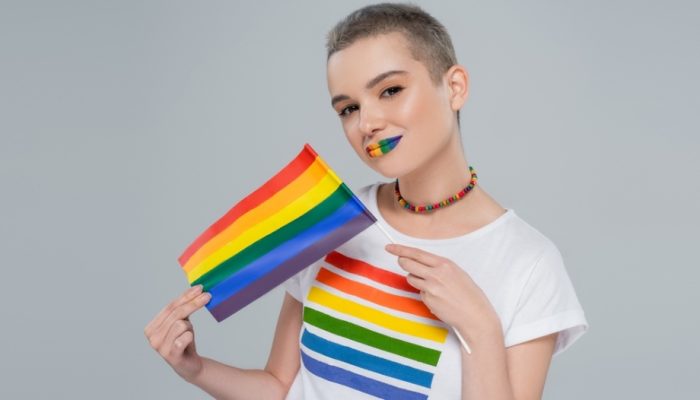
We’ve created this LGBTQ+ Mini-Dictionary for those who may not be entirely familiar with the terminology and labels used in an LGBTQ+ context, and moreover, as contextual support for a better understanding of the chapters in our eBook Queer Somatics.

The definitions are mostly taken from the LGBTQIA+ Wiki. The LGBTQIA+ Wiki is a dedicated resource for LGBTQIA+ topics, including sexual and romantic orientations, gender identities, and the LGBTQIA+ community as a whole.
However, the actual number of LGBTQIA+ terms and labels is much, much larger than you’ll find in this LGBTQ+ Mini-Dictionary. In fact, we’ve simply chosen those terms and labels we think are most commonly used in mainstream society and/or which we address in our book.
At any rate, below then an alphabetical list of common LGBTQIA+ terminology. In some of the descriptions you’ll also find links to articles on our site that delve deeper into a specific topic.
Agender
Agender, also known as genderless or gender neutral, is a gender identity that has been defined multiple ways, including:
- Without gender (literal meaning); not having a gender; the feeling of a gender is absent.
- Having a gender and that gender is neither “man” nor “woman”; being gender neutral in relation to the gender binary of male/female, man/woman, and masculine/feminine.
- Not identifying with any gender; finding the concept of “gender” to be personally irrelevant or rejecting it for one’s self.
- Rejecting the concept of gender entirely, not just personally.
Ally
When used in relation to the LGBTQIA+ community, an ally or an accomplice is someone who supports LGBTQIA+ people in partnership with them and advocates for them, even without having a direct stake in the cause, such as a cisgender person who actively supports transgender rights. Being an ally is not considered an identity; it is an ongoing process that requires action and continuous learning.
Androgyne
Androgyne is a gender identity in which a person has a gender that is a blend of both binary genders. People who are androgyne may describe this as being “between” female and male, man and woman, masculine and feminine, or simply “in between.” They may also identify as neither feminine nor masculine, or neither female nor male.
Aromantic
Aromantic, often shortened to aro, describes people who do not experience romantic attraction, or experience little-to-no romantic attraction. One of the meanings of the A in LGBTQIA+ is Aromantic. Aromanticism is a romantic orientation and may involve forms of attraction that are not necessarily romantic, or interests in relationships that are intimate in other ways. There is no singular experience of aromanticism.
Asexual
Asexual refers to people who do not experience sexual attraction toward others, as well as people who experience limited or conditional sexual attraction and relate to the label asexual more than other sexual identity terms. They may experience other forms of attraction, such as romantic, sensual, or aesthetic attraction. Asexuality is a sexual orientation, not a behavior, choice, or medical condition.
Some asexual people choose to engage in sexual activities for various reasons despite not experiencing sexual feelings and desire toward any particular person.
Bigender
Bigender is a gender identity in which a person has or experiences two genders. The genders may be any combination of two genders, and those genders can be binary (“man” or “woman”) or non-binary. They may be experienced simultaneously or may alternate, and they may not be experienced equally or in the same way. For example, a bigender person may be both a woman and a man, agender and neutrois, or non-binary and a woman.
Biromantic
Biromantic is a term used to describe people who are capable of feeling a romantic connection to people of any two or more specific and distinct gender identities.
Birth Assignment
Birth assignment, also called gender assignment or assigned gender at birth (abbreviated AGAB), refers to assigning a gender to an infant based on their designated sex at birth, which is usually based only on the appearance of their external genitalia. Birth assignments are recorded as “sex” on birth certificates with the assumption that an individual’s eventual gender identity will match their birth assignment — assigned male at birth (AMAB) or assigned female at birth (AFAB).
People whose gender identity aligns with their birth assignment are cisgender; transgender people have a gender identity that differs from their assigned gender at birth. This practice also ignores natural sexual variations, such as various intersex traits, or treats those variations as problems to be “fixed.”
Bisexual
Bisexual, also abbreviated as bi, is a sexual orientation encompassing attraction to multiple genders and/or sexes, with the attraction being sexual, romantic, and/or emotional. Bisexuality is not limited to the gender binary, but it is often misunderstood as that. The term does not have a single, universal definition or strict rules as to who may identify as bisexual. The many definitions include the following:
- Attraction to women and men, sometimes phrased as “both sexes.”
- Attraction to people of the same gender as one’s self and to people of other genders.
- Attraction to more than one gender or more than one sex.
- Attraction to two genders.
- Attraction to all genders.
- Or definitions may be based on engagement in romantic or sexual relationships instead of attractions.
Cisgender
A cisgender person is someone who is not transgender and can thus also be referred to as a non-transgender person. It is often shortened to cis, which comes from the Latin prefix “cis-“ meaning “on the same side of”, making it an antonym of “trans-“.
Cisgender people have a gender identity that matches the gender or sex they were assigned at birth. Their gender expression or gender presentation may be gender non-conforming, such as a femme man who was assigned male at birth. Mind that people who are heterosexual (straight), gay, lesbian, bisexual, or asexual and identify themselves as the sex assigned to them at birth are cisgender.
Drag
Drag is a type of performance art created by the queer community that involves exaggerated attire resembling the “opposite sex,” or other forms of gender expression. The art form originated in the late 16th and early 17th centuries, though the concept of cross-dressing has been around far longer.
Note: mind that the activity of drag is categorized under the broader term of cross-dressing. As it is, cross-dressing can be practiced for various reasons, such as to disguise, comfort, entertain (drag artistry), and/or to express oneself.
Feminine
Femininity is a set of behaviors, presentations and roles which are culturally associated with being a woman and/or possessing female sex characteristics. People of any gender identity or sexual orientation can be feminine, as femininity is not designated by biological sex or gender. It is labeled as possessing many traits, including “empathy, sensitivity, and gracefulness,” which many individuals are capable of feeling.
Gay
Gay is an adjective referring to those with an enduring physical, romantic, and/or emotional attraction to people of the same gender. This is most commonly associated with gay men, as a gay woman may prefer to use the term “lesbian” instead. Queer and bisexual are also among the terms used for those who are attracted to members of the same gender.
In a broader sense of the word, gay can also be used as an umbrella term to identify any LGBTQIA+ individual, though some note that doing so excludes other sexual orientations and gender identities and should thus be avoided.
Gender
Gender is generally defined by behavioral, cultural, or psychological traits. Although gender and sex have historically been equated, they are increasingly understood as being separate. Gender is a complex combination of elements that are assigned certain meanings by society, such as an individual’s identity, expression, and presentation, as well as the roles and norms associated with those genders.
Definitions of gender vary among different cultures and among individuals. It has often been reduced to a binary of “male” and “female.”
Note: an in-depth explanation of the difference between gender and sex can be found on the website of the Council of Europe in their article Sex and gender.
Gender Affirmation
Learn more about Gender Affirmation in our post Gender Affirmation – What’s It About?
Gender Diverse
The term gender diverse is not defined within the LGBTQIA+ Wiki, but we mention it here because we frequently use it in our book and throughout the website.
Although the use of the label “gender diverse” can have slightly different connotations, we rather use it an inclusive term that describes people whose gender identity and expression fall outside of the gender binary or cisgender realm.
Gender Dysphoria
Learn more about Gender Dysphoria in our post Gender Dysphoria Explained.
Gender Expression
Gender expression is how someone chooses to outwardly express their gender in public. Gender expression is external manifestations of gender, while gender identity is internal. Expression includes a person’s name, pronouns, body characteristics, voice, behavior, and aesthetic choices such as hair, clothing, and cosmetics.
Various forms of expression are regarded as “masculine” or “feminine” within different cultures. Some transgender people seek to align their gender expression with their gender identity.
Gender Identity
Gender identity is a person’s internal, deeply held sense of their own gender (or lack thereof). Unlike gender expression, gender identity is not visible to others. An individual’s gender identity may or may not align with their birth assignment.
Most people have a binary gender identity — male/man/boy or female/woman/girl — whether they are cisgender or transgender. For other people, their gender identity does not fit neatly into one of those two options, such as people who are non-binary or genderqueer.
Gender Neutral
See the term Agender in this LGBTQ+ mini-dictionary.
Gender Non-Conforming
Gender non-conforming is a term describing people who do not follow gender stereotypes and differ from their society’s conventional binary expectations of masculine men and feminine women. Gender non-conformity can encompass many things, such as gender expression, gender roles, or another aspect of gender.
It is typically apparent in people whose gender identity is a binary gender (male or female), whether they are cisgender or transgender; for instance, a feminine trans man and a feminine cis man are both non-conforming with expectations of masculinity. Other terms include gender diverse, gender expansive, and gender variant.
Genderfluid
Genderfluid, or simply fluid, refers to someone whose gender identity changes over time. A genderfluid individual can identify as any gender, or combination of genders, at any given time. Their gender can change at random, or it may vary in response to different circumstances. At times, these individuals may identify as male, female, both, or neither. Their pronouns may vary at different times.
The term genderfluid can be used as a specific identity in itself or as a descriptive term. They are generally considered under the non-binary and transgender umbrellas, but not all genderfluid individuals identify with those terms. Some genderfluid people transition socially, physically, and/or legally.
Genderqueer
Genderqueer is a gender identity that is neither male nor female, is a combination of the two binary genders, is on a continuum between those two genders, or queers gender in some way. Both genderqueer and non-binary can be seen as umbrella terms or as more specific identifiers. Some, but not all, genderqueer people identify as transgender.
Heterosexual
Heterosexual, or straight, refers to the sexual orientation of an individual as attracted to people of a gender different than their own. It is commonly used to mean a woman attracted to men or a man attracted to women, which is often called the “opposite” gender.
Homosexual
Homosexual, i.e. gay or lesbian, is a sexual orientation where a person is attracted to people who have the same gender as themselves.
Intersex
Intersex is an umbrella term for people who are born with or develop sex characteristics that differ from the binary notions of a “male” or “female” body. The dissimilarities between individuals in terms of their hormones, chromosomes, external and internal reproductive organs, or secondary sex characteristics are commonly referred to as variations.
An individual’s intersex traits may include variations in one or multiple of the aforementioned types. These variations can be noticed at birth or later in life.
Lesbian
Lesbian is a sexual orientation or romantic orientation most often defined as a woman who is attracted to other women, with many variations in definitions. Although lesbians are frequently defined as women who are attracted to women exclusively/solely, they are also defined as women attracted to women primarily/mainly. Some prefer to use or additionally use “gay” or “gay woman” as an identifier.
Masculine
Masculinity is a set of behaviors, presentations, and roles which are culturally associated with being a man and/or possessing male sex characteristics. People of any gender identity or sexual orientation can be masculine, as masculinity is not designated by biological sex or gender. It is labeled as possessing many traits, including “strength, drive, and leadership”, which many individuals are capable of feeling.
Misgendering
Misgendering is the act of purposefully or accidentally referring to a person with incorrect or non-preferred pronouns or by another gender-related term that is wrong for them, such as the honorifics “Mr./Mister”, “Miss”, or “Mrs./Missus”. Some transgender or non-binary people experience being misgendered on a daily basis. Using the correct terms for other people shows respect and support, unlike misgendering.
Monosexuality
Monosexuality is an umbrella term for anyone whose sexual orientation involves attraction to one gender only. It can include individuals who are gay, lesbian, straight, etc. It is the opposite of multisexual or bisexual. The bisexual community was using the term monosexual by 1991 to mean non-bisexual people.
Multigender
Multigender is a gender identity where a person experiences more than one gender. More generally, multigender is used as an umbrella term for any gender identity that involves more than one gender at a time. This includes identities such as bigender, pangender, and can even include fluid identities such as genderfluid and genderflux.
Multisexual
The multisexual spectrum (abbreviated m-spec) is also known as multiple-attraction spectrum, or multi-attraction spectrum. It is an umbrella term for sexual orientations in which a person is sexually and/or romantically attracted to more than one gender and/or sex. Multisexuality collectively includes labels such as bisexual, omnisexual, pansexual, and queer, along with the standalone multisexual label.
Non-binary
Non-binary, sometimes written as nonbinary, is a term referring to individuals whose gender identity does not exclusively fall into the binary gender classification of only “man” or “woman.” Those who are non-binary may appear either masculine or feminine in some capacity, both, or neither at all. Although it is a gender identity on its own, it can also be used as an umbrella term to refer to many gender identities.
While non-binary is included in the transgender umbrella, not all non-binary people identify as transgender; some identify as cisgender. Since identifying as non-binary can mean different things to different people, it is best to ask someone who uses the term what it means to them.
Pronouns
In English, some pronouns have strong social associations with a specific gender identity, typically she/her with women and he/him with men. Although certain pronouns are used more often by certain genders, pronouns do not necessarily indicate an individual’s gender identity.
For instance, someone who uses the pronouns she/her may be a genderfluid or agender person instead of a binary female person. When someone’s pronouns are not known, using the gender neutral singular they/them is recommended. The singular they/them is grammatically correct; more importantly, it is respectful.
Queer
Queer is an identifier for individuals who are not exclusively heterosexual in their sexual orientation, who use it in reference to their gender identity and/or gender expression (as a standalone term or part of another like genderqueer), or who are fluid in their identities, as well as an umbrella term for the entire community.
It is also used instead of lesbian, bisexual, or gay by some people who find those terms too limiting or loaded with connotations that do not apply to them. The “Q” in LGBTQIA+ and similar acronyms commonly means Queer. As a reclaimed word, it has been used in fights for LGBTQIA+ rights and liberation as an inclusive and sometimes defiant term.
Note: The word Queer is not universally accepted and some people within the LGBTQ+ community may feel that the word has been used for too long in a derogatory way and don’t like or object to using it.
Questioning
Questioning is a term used to describe individuals who are exploring, learning, or experimenting with their sexual or romantic orientation, or gender identity. The letter “Q” in the LGBTQIA+ acronym can sometimes stand for both “Queer” and “Questioning”.
Romantic Orientation
Romantic orientation is a term that originates with asexual communities. It is related to a person’s romantic attractions or desires, whereas sexual orientation is associated with sexual attractions. Romantic orientation is generally expressed in terms of which gender or genders a person is attracted to in relation to the person’s own.
Although a person’s sexual and romantic attractions are usually implied by the same word used for their sexual orientation, a person’s romantic and sexual orientation may differ.
Sex
Sex is a medical term used for the classification of people as “male” and “female”, usually as a birth assignment based on the appearance of an infant’s external genitalia. However, sex is more complicated than that. A person’s sex is a combination of bodily characteristics including: chromosomes, hormones, internal and external reproductive organs, and secondary sex characteristics that develop during puberty.
The common division of sex into strictly “male” and “female” ignores natural sexual variations that do not easily fit into one of the two categories, such as various intersex traits. Problematic and medically inaccurate language for sex includes phrases like “biologically [fe]male”, “genetically [fe]male”, or “born a [wo]man]”. Such phrases over-simplify the complexities of people’s biology and regard birth assignments as more important than gender identity.
Sexual Orientation
Sexual orientation, also known as sexuality, refers to a person’s sexual attractions (or lack thereof) toward other people. It is not defined by sexual activity, which can be independent of a person’s orientation.
Note: sexual orientation is an enduring personal pattern of sexual attraction to persons of the opposite sex or gender, the same sex or gender, or to both sexes or to more than one gender.
Transgender
Transgender, often shortened to trans, is an umbrella term that describes an individual whose gender identity differs from their assigned gender at birth (AGAB). Infants are assigned a sex based on the appearance of their external genitalia, usually only on that basis, and that assignment is recorded on their birth certificate.
The birth assignment — generally defaulting to assigned male at birth (AMAB) or assigned female at birth (AFAB) — assumes that the individual’s gender identity will correspond to their assigned sex.
A person’s gender identity — their sense of gender — usually develops when they are very young. The realization that their gender is different from what they were assigned can occur as early as three years old or in childhood prior to the onset of puberty. It may also happen later in life.
Transition
Transition is the process a transgender individual may undergo to align their gender expression with their gender identity. Transitioning can be medical, social, or both.
While many transgender people choose to transition to some degree, it is highly individual and not accessible or desirable for everyone; medical transition is often harder to access, while social transition may be unsafe or unwanted. There is no defined state where one’s transition is “complete” — it varies based on the individual’s needs.



















